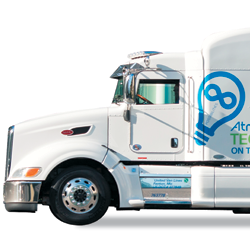|
case study

Mixed Signals
To prove the power of its Eqo cellphone-signal booster, WeBoost LLC employs a 180-year-old invention that puts its product to the ultimate test, generating sales leads and media coverage in the process. By Charles Pappas
From Timex Group USA Inc. in the 1950s to Blendtec Inc. in 2016, some of history's most successful companies relied on risky and even radical demonstrations to propel their products from obscurity to ubiquity. To prove its timepieces could "Take a lickin' and keep on tickin'," Timex secured its watches to a violently churning motorboat propeller and a stomping elephant's foot on live TV. Likewise, to validate its claim that its household appliances are rugged enough to outlive you and become "The Last Blender You'll Ever Own," Blendtec stuffed iPhones, golf balls, marbles, and other unlikely objects into its signature product and pureed them on video. But in an age when products are increasingly more pixel than physical, demonstrating their capabilities in a way that connects with customers can be as abstract a matter as a Picasso painting. That was the monumental challenge WeBoost LLC faced at the 2016 International Consumer Electronics Show (CES) in Las Vegas.
A subsidiary of 50-year-old Wilson Electronics LLC, the St. George, UT-based WeBoost was planning on unveiling Eqo, a product that enhances cell and data signals by as much as 32 times, turning barely there service into "Can you hear me now?" coverage. Like most potentially successful products, the Eqo was designed to address a common problem: cellphones' frequent signal loss and dropped calls. But the days of single-function cellphones are long gone. Today's cellphone users are also streaming videos, playing music, browsing the internet, and navigating from point A to point B via maps and GPS signals. In fact, according to Pew Research Center's American Trends Panel, an astonishing 76 percent of users rarely or never turn their cellphones off, expecting – and depending on – constant coverage. Given that almost junkie-heroin relationship between users and their communication devices, then, the Harris Poll finding that 69 percent of people experience dropped calls, slow data, poor signals, and the dreaded "dead zones" that render their phones useless, suggested WeBoost could very well have a game-changing product in the Eqo. "We felt our strategy needed to somehow show the Eqo's capabilities in a tangible way that consumers could trust," says Taylor White, Wilson Electronics' manager for public relations and social media. "But how?" That was the question. Complex printed literature? Elaborate touchscreen animations? Slick technical experts giving live presentations? Working with Czarnowski Display Services Inc., the WeBoost team debated numerous ways to hold attendees in thrall and convince them of Eqo's utility. Then it realized that the most effective approach could be to replicate in some way the very situations that cause signal degradation in the first place. "We wanted to simulate the conditions many people experience on a frequent basis that cause loss of cellphone signal and then demonstrate how effectively the Eqo solves that problem," White says. For example, people living and working in remote locations can suffer from weak signals because of natural obstructions such as mountains or trees or because of their sheer geographic distance from a cell tower. Those in urban areas aren't necessarily better off, often experiencing significant signal loss due to the thick concrete and dense metal comprising the towering buildings that surround them. Even layers of insulation can form barriers that render signals unreliable. So to prove its product's claims, WeBoost set out to recreate those conditions on the CES trade show floor. 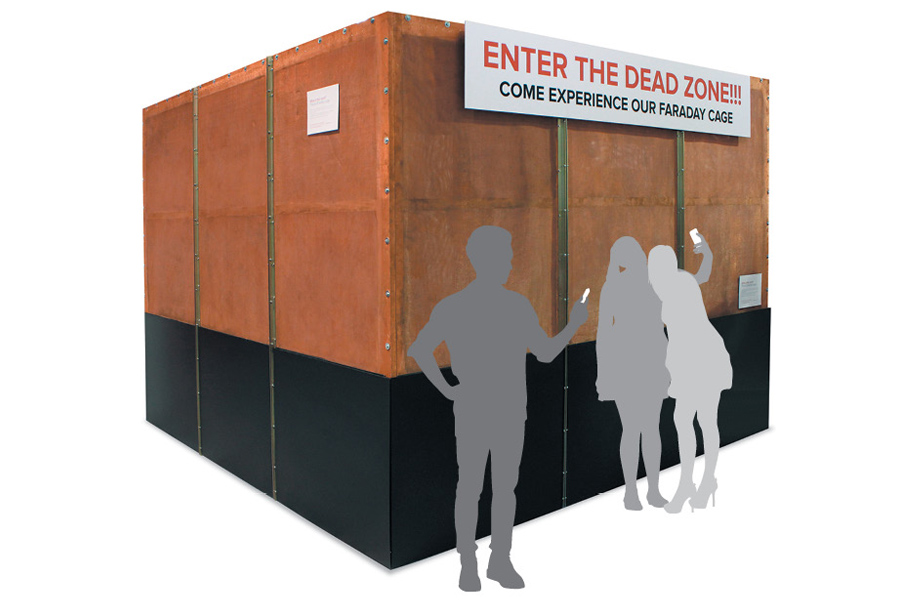
WeBoost LLC employed a Faraday cage to demonstrate to International Consumer Electronics Show attendees how its Eqo unit can boost signals
to mobile devices.
Cage MatchReplicating real-world dead zones in an exhibit would be both exacting and exorbitant. Plus, since the Wi-Fi and cellular signals within the Las Vegas Convention Center would likely fluctuate during the show, it would be next to impossible to establish a signal baseline against which to measure the Eqo's amplification. Realizing it needed something that would leave no room for argument about the Eqo's powers, WeBoost found its solution for this 21st-century challenge in an apt 1836 invention. Devised by the English scientist Michael Faraday four decades before Alexander Graham Bell spoke the first words into a telephone, the eponymous Faraday cage might help WeBoost offer the vivid proof it sought for the Eqo's prowess. Formed by wrapping conductive material, or a mesh of such materials, around an enclosure, Faraday cages prevent electric fields, radio waves, and mobile-phone transmissions, for instance, from penetrating the enclosure. As such, when attendees later ventured inside the cage, which would be dubbed the "double RF isolated enclosure," their phones would register zero bars, making it impossible for them to complete a call or open a web-enabled app. In other words, the smartphone signals that often seem as pervasive as air would, for all practical purposes, be as dead as Faraday himself. Assuming the company's boast was valid, the Eqo would be able to punch through the electromagnetic blockade with ease, amplifying the undetectable cell signal to reliable levels. So WeBoost would construct the cage, while the rest of what would be a 1,500-square-foot exhibit would be designed and fabricated by Czarnowski and used for displaying the Eqo and WeBoost's other products. Daring Demo It was a lottery-ticket kind of wager because Faraday cages are not noted for their porousness in protecting, for example, hospital equipment from unwanted electronic interference, or in guarding government offices from undesired electronic surveillance. Thus, if the cage did its job and the Eqo did not, the demo might prove adverse rather than advantageous, damaging the WeBoost brand beyond the possibility of redemption.But like most effective demonstrations, its potential benefit existed in direct proportion to its risk of failing. It was a gamble, but a calculated one, that could help set WeBoost apart from competitors the way that Timex and Blendtec elevated their brands into cultural icons via equally dicey demos. "If a brand can only afford one marketing element and the product is meaningfully superior to competitors," says Michelle Greenwald, author of "Catalyzing Innovation" and marketing professor at New York University and Columbia University, "I would recommend conducting a demonstration. Demoing or sampling enables consumers to see how products perform without having to risk buying first, which is essential – especially for high-value purchases." With the strategy for the show in place and its execution imminent, WeBoost then turned its attention to its goals for CES, which were twofold. First, while it understandably wanted to capture as many of the show's approximately 104,000 consumer attendees as possible, the company focused on 150 business-to-business buyers. WeBoost concluded that a tipping point for the product couldn't be reached without compiling sales leads from no fewer than 25 of those targeted attendees. Second, for the tipping point to become a toppling point, it would need publicity from several high-profile tech magazines. For that latter goal, WeBoost hoped to garner coverage in at least 10 publications from an imposing roster of tech-related media outlets. Two days prior to the opening of CES, the company began boosting its social-media efforts by organizing an Eqo giveaway for every day of the show. WeBoost posted notices about the contest on Facebook and Twitter, along with videos posted to its YouTube channel, urging viewers to use the hashtag #WeBoostFaraday to be entered into the drawings. Moreover, by staging a giveaway online, the company hoped to expand its exhibit's reach to potential buyers who were unable to attend CES. 
Kiosks positioned throughout the exhibit offered touchscreen demos of WeBoost's other mobile- and home-based products.

Once inside the Faraday cage, participants saw that signals to their mobile devices were completely cut off. When WeBoost's Eqo unit was activated, cellular and Wi-Fi signals were fully restored.
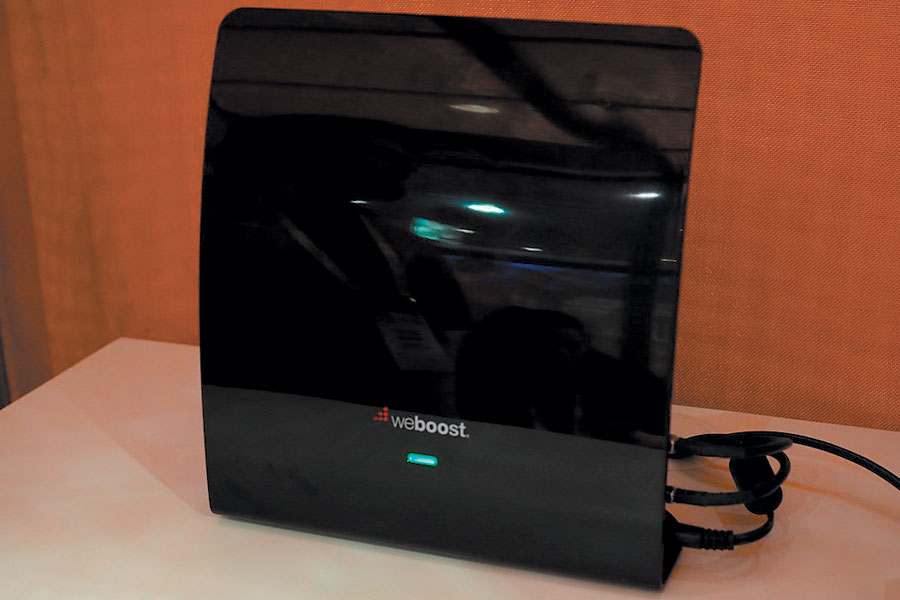
WeBoost's Eqo unit was placed on a table inside the Faraday cage and activated once participants realized their mobile devices weren't receiving any signal.
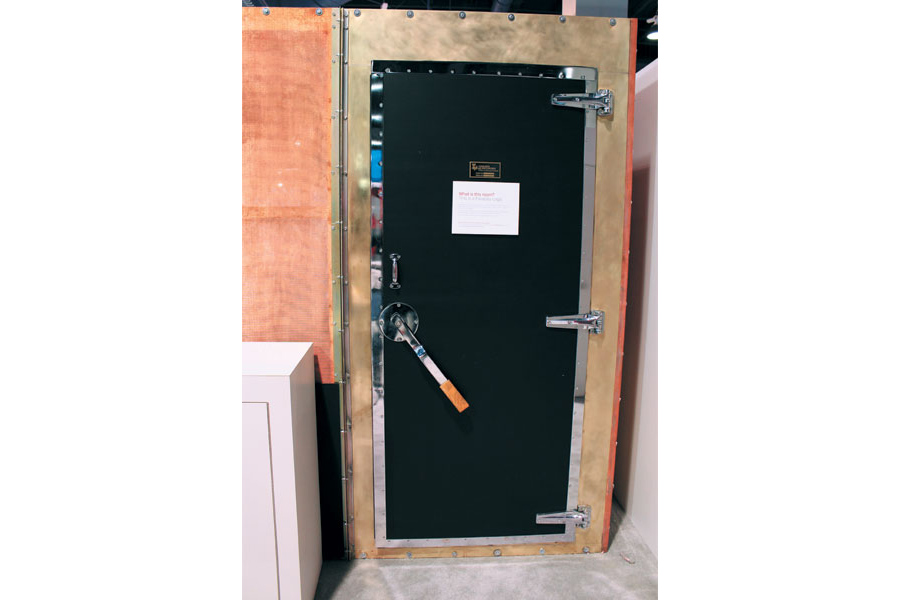
A 300-pound steel door sealed participants inside the Faraday cage, which measured 100 square feet and tipped the scales at 800 pounds.
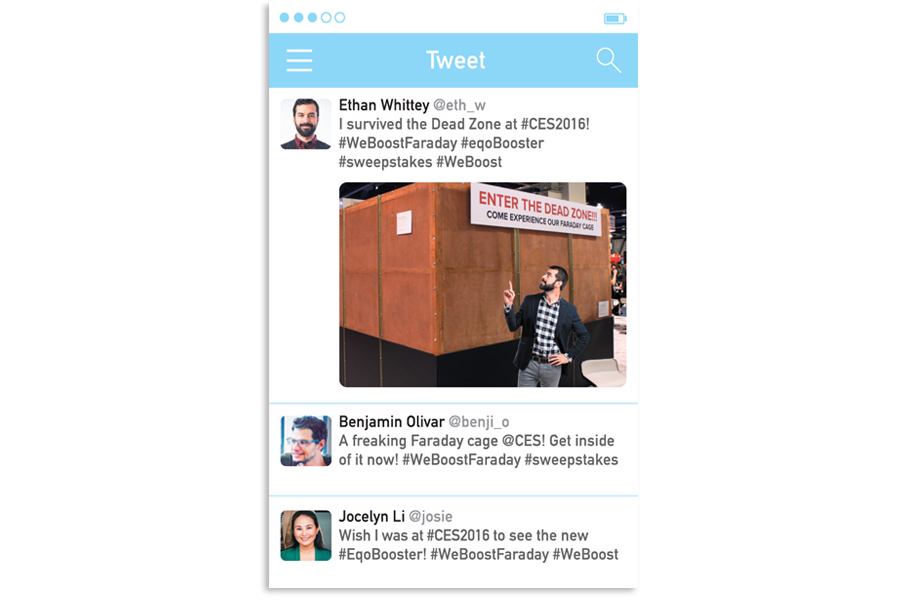
Every day of the show, WeBoost offered an Eqo giveaway and posted notices about the contest on multiple social-media platforms. CES attendees and the company's social-media followers were encouraged to use the hashtag #WeBoostFaraday to be entered in the drawings.
The Dead ZoneFrom the moment CES opened its doors, the Faraday cage trapped not just signals but also attendees' attention. Hundreds of visitors passing by WeBoost's 30-by-50-foot exhibit stopped in their tracks when they encountered the sight of the forbidding construction that looked like it might house a dangerous X-Men villain. On one side of the structure, printed in red and black letters, was the company's challenge to "Enter the Dead Zone!!! Come Experience our Faraday Cage" in carnival-barker tones that hinted something curious and strange might be lurking within. For instance, at the 1939/1940 New York World's Fair, Swift & Co. meat packers constructed an almost hospital-clean area to illustrate how safely its hot dogs were processed, showing how they were prepared solely by sanitary machinery, untouched by contaminated human hands. More recently, at Expo 2010 in Shanghai, Salvatore Ferragamo S.p.A. displayed a shoemaker cobbling its luxe footwear by hand. While the eras and products are radically different, they share one thing in common: an object whose creation would entertain and perhaps enthrall onlookers. To further pique potential booth visitors' curiosity, WeBoost recorded three other videos about the cage and the Eqo, releasing them throughout the show. In one, a WeBoost staffer tossed a black rubber ball against the cage exterior to illustrate in a tangible way how electromagnetic emissions would ricochet off it. In another, Jeff Gudewicz, WeBoost's vice president of corporate development, repeated the rubber ball demonstration against the cage's daunting ebony-colored front door and then entered the cage to demonstrate how it blocked signals to his phone – and how the Eqo restored them instantly. The last video showed more time-lapse action, this time of attendees entering the booth and the cage during CES show hours. 
Some attempted to make calls, run applications, or open a website, but uniformly failed, as their devices had become little more than expensive paperweights. While the dramatic demo held attendees' attention as tight as a noose, a staffer approached the table where the enigmatic-looking Eqo sat, theatrically switched it on, and demonstrated the device's efficacy as signals flooded back to attendees' phones. Over and over, at least 50 times a day, groups of six to eight attendees at a time entered the cage, only to experience the same astonishing loss of signal – which then reappeared every time as if a cell tower had magically materialized right inside the cage's shielded walls. Once the demo was over, visitors could explore the other areas of the booth, including a set of 8-foot-tall, wood-framed bookcases displaying WeBoost offerings. In another section of the exhibit, a pair of kiosks featured touchscreen demos of other mobile- and home-based products. 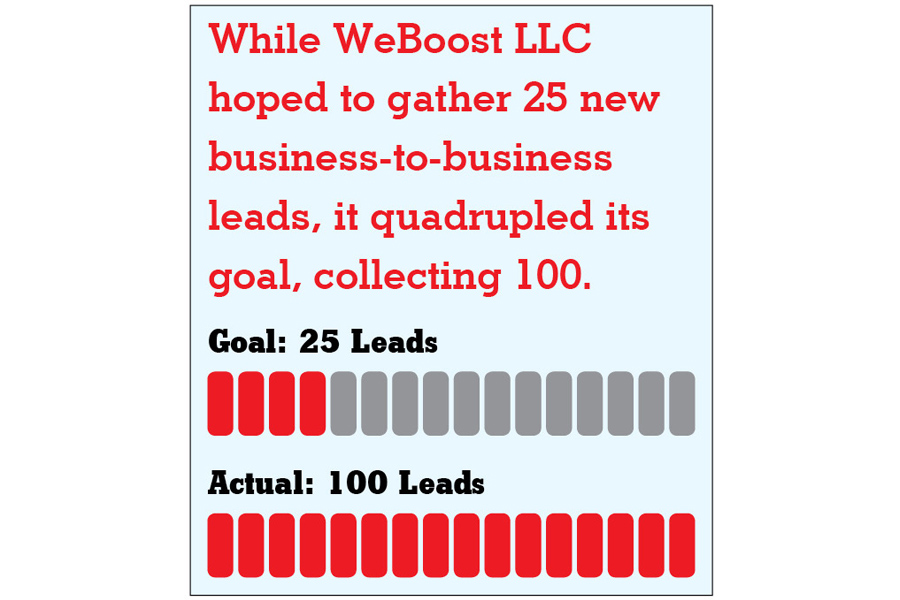
"Those who dare to fail miserably can achieve greatly," Robert Kennedy said. If the Faraday cage had muffled most but not all phones, or if the Eqo had restored signals to many but not every communication device, the demonstration might have been diluted or perhaps disastrous. But what WeBoost achieved was impressive when gauged by any of several metrics. The Faraday-cage demonstration drew approximately 1,600 participants, and the online giveaway generated roughly 325,000 of what the company termed "social engagements," including likes, retweets, comments, and more, as well as more than 400 entries into the drawing. But when it came to its officially stated goals, the company produced the equivalent of five bars. Hoping for leads from at least 25 business-to-business buyers, it quadrupled its goal, racking up 100. Looking to obtain publicity from 10 prestigious technology publications, it exceeded that objective by half, garnering coverage in 15 – including The Verge, as well as Tom's Guide and TechHive. By putting its product to the test in a live demonstration that risked failure and then reaped extraordinary results in sales leads and media coverage, WeBoost proved its message about the Eqo had been received loud and clear. E
|
|
|
||||||||||||||||||||||||||||
|
|
||||||||||||||||||||||||||||
|
TOPICS Measurement & Budgeting Planning & Execution Marketing & Promotion Events & Venues Personal & Career Exhibits & Experiences International Exhibiting Resources for Rookies Research & Resources |
MAGAZINE Subscribe Today! Renew Subscription Update Address Digital Downloads Newsletters Advertise |
FIND IT Exhibit & Display Producers Products & Services All Companies Get Listed |
EXHIBITORLIVE Sessions Certification Exhibit Hall Exhibit at the Show Registration |
ETRAK Sessions Certification F.A.Q. Registration |
EDUCATION WEEK Overview Sessions Hotel Registration |
CERTIFICATION The Program Steps to Certification Faculty and Staff Enroll in CTSM Submit Quiz Answers My CTSM |
AWARDS Sizzle Awards Exhibit Design Awards Portable/Modular Awards Corporate Event Awards Centers of Excellence |
NEWS Associations/Press Awards Company News International New Products People Shows & Events Venues & Destinations EXHIBITOR News |
||||||||||||||||||||
|
||||||||||||||||||||||||||||




